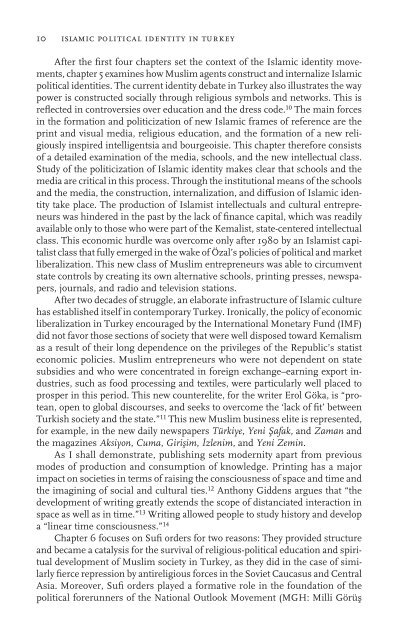You also want an ePaper? Increase the reach of your titles
YUMPU automatically turns print PDFs into web optimized ePapers that Google loves.
10 islamic political identity <strong>in</strong> turkeyAfter the Wrst four chapters set the context of the <strong>Islamic</strong> identity movements,chapter 5 exam<strong>in</strong>es how Muslim agents construct and <strong>in</strong>ternalize <strong>Islamic</strong>political identities. The current identity debate <strong>in</strong> <strong>Turkey</strong> also illustrates the waypower is constructed socially through religious symbols and networks. This isreXected <strong>in</strong> controversies over education and the dress code. 10 The ma<strong>in</strong> forces<strong>in</strong> the formation and politicization of new <strong>Islamic</strong> frames of reference are thepr<strong>in</strong>t and visual media, religious education, and the formation of a new religiously<strong>in</strong>spired <strong>in</strong>telligentsia and bourgeoisie. This chapter therefore consistsof a detailed exam<strong>in</strong>ation of the media, schools, and the new <strong>in</strong>tellectual class.Study of the politicization of <strong>Islamic</strong> identity makes clear that schools and themedia are critical <strong>in</strong> this process. Through the <strong>in</strong>stitutional means of the schoolsand the media, the construction, <strong>in</strong>ternalization, and diVusion of <strong>Islamic</strong> identitytake place. The production of Islamist <strong>in</strong>tellectuals and cultural entrepreneurswas h<strong>in</strong>dered <strong>in</strong> the past by the lack of Wnance capital, which was readilyavailable only to those who were part of the Kemalist, state-centered <strong>in</strong>tellectualclass. This economic hurdle was overcome only after 1980 by an Islamist capitalistclass that fully emerged <strong>in</strong> the wake of Özal’s policies of political and marketliberalization. This new class of Muslim entrepreneurs was able to circumventstate controls by creat<strong>in</strong>g its own alternative schools, pr<strong>in</strong>t<strong>in</strong>g presses, newspapers,journals, and radio and television stations.After two decades of struggle, an elaborate <strong>in</strong>frastructure of <strong>Islamic</strong> culturehas established itself <strong>in</strong> contemporary <strong>Turkey</strong>. Ironically, the policy of economicliberalization <strong>in</strong> <strong>Turkey</strong> encouraged by the International Monetary Fund (IMF)did not favor those sections of society that were well disposed toward Kemalismas a result of their long dependence on the privileges of the Republic’s statisteconomic policies. Muslim entrepreneurs who were not dependent on statesubsidies and who were concentrated <strong>in</strong> foreign exchange–earn<strong>in</strong>g export <strong>in</strong>dustries,such as food process<strong>in</strong>g and textiles, were particularly well placed toprosper <strong>in</strong> this period. This new counterelite, for the writer Erol Göka, is “protean,open to global discourses, and seeks to overcome the ‘lack of Wt’ betweenTurkish society and the state.” 11 This new Muslim bus<strong>in</strong>ess elite is represented,for example, <strong>in</strong> the new daily newspapers Türkiye, Yeni 6afak, and Zaman andthe magaz<strong>in</strong>es Aksiyon, Cuma, Giri7im, 8zlenim, and Yeni Zem<strong>in</strong>.As I shall demonstrate, publish<strong>in</strong>g sets modernity apart from previousmodes of production and consumption of knowledge. Pr<strong>in</strong>t<strong>in</strong>g has a majorimpact on societies <strong>in</strong> terms of rais<strong>in</strong>g the consciousness of space and time andthe imag<strong>in</strong><strong>in</strong>g of social and cultural ties. 12 Anthony Giddens argues that “thedevelopment of writ<strong>in</strong>g greatly extends the scope of distanciated <strong>in</strong>teraction <strong>in</strong>space as well as <strong>in</strong> time.” 13 Writ<strong>in</strong>g allowed people to study history and developa “l<strong>in</strong>ear time consciousness.” 14Chapter 6 focuses on SuW orders for two reasons: They provided structureand became a catalysis for the survival of religious-political education and spiritualdevelopment of Muslim society <strong>in</strong> <strong>Turkey</strong>, as they did <strong>in</strong> the case of similarlyWerce repression by antireligious forces <strong>in</strong> the Soviet Caucasus and CentralAsia. Moreover, SuW orders played a formative role <strong>in</strong> the foundation of thepolitical forerunners of the National Outlook Movement (MGH: Milli Görü7




